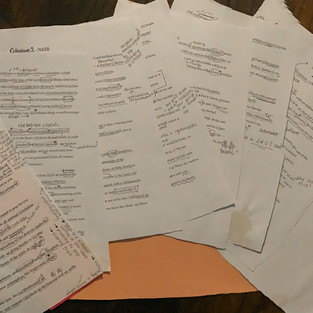
Outlining & Paraphrasing
Outlining the structure of the text AND paraphrasing portions of scripture have proven to be one of the most challenging, yet fruitful, tools in my own personal study. Both of these tools are exactly what they sound like, pretty straight forward, and leave a lot of room for personalization so don’t overcomplicate it or box yourself in to doing things just like my “examples”. (I’ve actually debated whether or not I should even include examples but I know when I’m trying something new, it helps me to see examples for inspiration.) I’m excited to share some “How-to” tips for these practices but most of all want to encourage you to try and see!
Outlining:
Create an outline of the passage of scripture you are studying. You make the call whether you create an outline for the chapter, section, or entire book and start chopping it up in outline form.
Helps us familiarize ourselves with the content and structure (or lack thereof) of the text.
Challenges us to organize the content of the text.
Highlights literary characteristics we may not have noticed otherwise (repetition, overall theme, etc.)
Encourages memorization of the overall theme and purpose of the text.
Helps us to scope out and see the “bigger picture” of the passage and how it fits into the overall plan of Redemption.
I've included some pictures are progressive of my thinking process. I used my annotations on the printed copies of the text and summarized main points on sticky notes to organize. Then, I re-read the main points on the sticky notes in order and grouped them together as they fit together in Main ideas. From there, I created an outline of the text. Keeping in mind that this was a letter, I started with an opening, ended with a closing, and organized the body in between. Think of this as the writing process but working backwards from the finished product.
Paraphrasing:
Rewrite scripture verses or passages in your own words without changing, dulling, or distracting from the original meaning. Pull from your “everyday vocabulary” to rewrite the scriptures when possible.
Helps us deepen our understanding of the scripture we are studying.
Encourages scripture memorization and application
Challenges our understanding as we keep the original meaning of the scripture.
Strengthens our ability to “speak scripture”
For our personal study and use only, as we can never replace the divinely appointed and written Word of God.
Confession time: I actually didn’t do this one for a really long time after I learned about it because I thought it was dumb (keeping it real with ya’ll always!) BUT after forcing myself to do it, when I developed and taught a 6-week course on “How to study the Bible,” I felt led to include this tool but needed to make sure it was worth it. Spoiler alert: It’s not dumb, I’m dumb for not trying it a long time ago because it is SUPER challenging in all the best ways and has been extremely helpful in writing scripture on my heart longterm.
Now that you’ve seen how I do it, grab your bible, piece of paper, and get to it!!
Not sure where to start?
Just pick one method to try and focus on first.
Practice over and over and over.
Start, lean on, and end with prayer.
Try your hand at outlining the same portion of scripture multiple times doing it differently each way.
Blindly point to a verse in your Bible and challenge yourself to re-write it in your own words.







Comments